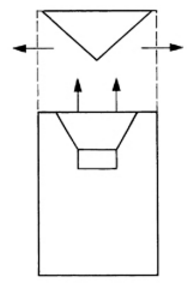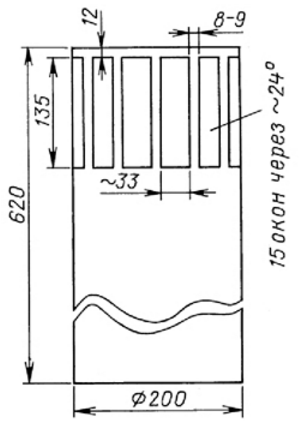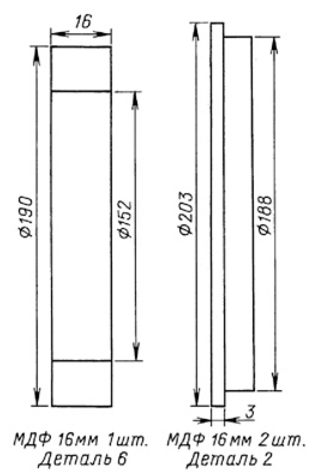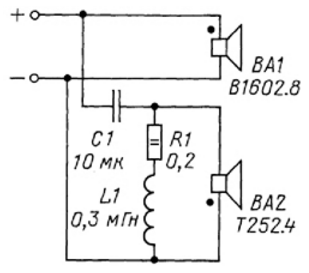
|
|
ENCYCLOPEDIA OF RADIO ELECTRONICS AND ELECTRICAL ENGINEERING Acoustic systems with a circular radiation pattern (AS spatial field). Encyclopedia of radio electronics and electrical engineering
Encyclopedia of radio electronics and electrical engineering / Audio equipment The main task of electroacoustic sound reproduction (in its most idealized version) is to ensure that the secondary sound field at the listening location corresponds to the primary sound field at the place where the action itself takes place. Being on the street, in the forest, in the field or in any other place, having listened, we can completely freely localize the sources of these sounds from all sides. Most sound sources in the world around us are close to point sources (compared to the wavelength of sound vibrations). These sources emit a dynamically changing spectrum of frequencies and, depending on the location of the sound source above the floor or ground level, a hemispherical or spherical wave is formed. Perhaps someone will object to me by giving the example of a vibrating string, but let's take an electric guitar on which the pickup is located closer to the end of the strings. It seems like there should only be high frequencies, but the pickup transmits a wide range of frequencies. Almost the entire spectrum of vibration frequencies can be removed from each section of the string. Let's mentally imagine the following experiment: in the wall of a room without windows, at a distance of, for example, 2 m, two holes facing the street are cut out with a diameter equal to the loudspeaker diffuser. Thus, we will get the equivalent of a speaker system that has a different radiation pattern for different frequencies, and for high frequencies the pattern will be narrower. We sit in a room and try to understand what is happening on the street. Now let's go outside - sounds will surround us. It is towards recreating the spatial sound field that the efforts of developers of spatial field acoustic systems (SFAs) are directed. Most existing systems are vector, i.e., directional radiation in at least part of the audio frequency band. The task of sounding a room is to fill it with a uniform sound field (pressure) at all its points without peaks and troughs. Let's imagine such an experiment - a mirror room, and it needs to be evenly illuminated. If we take directional light lanterns (vector emitters), we will get individual rays of light reflected from the mirror walls; there will be peaks and troughs. If we take a non-directional matte lamp (or two spaced lamps), we will get a room filled more evenly with light. From this experiment we get the conclusion: less directional sound radiation from the speakers creates a more uniform sound field. The dynamic heads used as sound sources do not allow reproducing the entire audible frequency range without noticeable distortion. To solve this problem, stripe heads are produced that are optimized for their frequency band. Thus, speakers consist of several heads spaced on the front panel of the speakers, and only a part of the audio signal spectrum is supplied to each of the strip heads, and each of these heads has its own directivity pattern. In multi-way speakers with spaced-apart dynamic heads, there are some problems: different delay times of signals in the bands due to delay in the crossover filters, imprecise emission of the sound spectrum, which leads to a shift in the radiation pattern in the area of separation of the bands. The different directional patterns of bandpass emitters, depending on the location of the listeners, lead to the timbre coloring of the sound of musical instruments. Conclusion: the secondary sound field fundamentally cannot correspond to the primary one - fig. 1. The inevitable question arises - what to do?
First, a little history. In 1898, Oliver Lodge invented the dynamic loudspeaker, the design of which has largely survived to this day. In 1948, Tannoy's first DualConcentric loudspeaker was introduced at the London Radio Show, the first two-way coaxial driver equivalent to a point source. This was indeed a breakthrough, which retains its advantages to this day, however, a coaxial loudspeaker with a horn high-frequency emitter has a very small comfortable listening area due to the sharpening of directivity with increasing signal frequency. In a coaxial design, the high-frequency emitter is located at the top of the cone of the low-frequency emitter, which acts as a moving (!) horn, influencing the timbre color depending on the position of the listener. The next step towards the creation of automatic transmission systems was made by engineer V.I. Shorov. The acoustic system 30AS103P developed by him was produced by the Yantar plant and was described in [1]. This is a two-way speaker, where two dynamic heads are installed in a horizontal plane and each directed at its own scattering cone, converting vector radiation into scalar (non-directional). Since the high-frequency emitter (head) is installed above the low-frequency one, we do not get an absolutely point source, but in the horizontal plane we get a source with a circular radiation pattern. Another step towards the creation of a point omnidirectional (more precisely, with a radiation pattern) sound source was the design (Fig. 2) proposed by Yu. Gribanov and A. Klyachin.
It has six pairs of heads installed on six sides of the speaker housing. This AS cannot be called an ASPP, since there is a vector component of the radiation. But it is a point omnidirectional sound source. There is one more drawback: the same signal is emitted by several heads and it is impossible to ensure their synchronous operation and identical parameters. This can lead to the loss of the subtlest nuances of the sound of the phonogram. The so-called counter-aperture AS (Fig. 3), proposed by A. Vinogradov and A. Gaidarov, more fully corresponds to the ideology of ASPP.
A virtual point omnidirectional sound pressure source is created in the full AF band. The vertical component of the sound wave is somewhat suppressed. But we again return to the same problem as in the previous case - we cannot obtain an absolutely symmetrical structure. At high frequencies, the sound waves emitted by the two heads may be out of phase, and the resulting interference will distort the original timbre. Distortion, of course, is less than in the previous method (fewer heads), but the problem remains. There is another problem associated with this design. Using two broadband heads does not always allow you to reproduce the required frequency range, even if you use coaxial (two-way) ones. It is not possible to implement the required three-lane structure in such a structure. The operating principle of the third type of automatic transmission system can be easily understood from the design conventionally shown in Fig. 4. Eliminating half of the set of loudspeakers for a counter-aperture speaker allows you to avoid its inherent disadvantages. Sound waves with a circular radiation pattern are also emitted here over the entire frequency range.
Currently, our company, which has a number of patents for similar speakers, produces automatic transmission systems in two structures. Two-way, made according to Fig. 5, are available in three volumes: 5, 10 and 40 liters for domestic use in living rooms. For small cinema halls, a special 1000 Watt automatic transmission system is produced, providing high sound pressure. The structure of ASPP, shown in Fig. 6, implements the three-band principle of spectrum division, which significantly simplifies the problem of selecting heads. Among the company's products there is also an automatic transmission system with a case volume of 70 liters; it is designed for high-quality reproduction of stereophonic phonograms.
If we talk about the features of ASPP, then in comparison with direct radiation speakers we can assume a slight weakening of the attack in the sound of instruments, since the sound is emitted in all directions, and not directed at the listeners. But what are the benefits of using such speakers in real rooms? An even spatial sound field is created - no matter where you are, the sound is the same timbre. Whether you stand in front of the speakers or to the side, the sound does not change, you are surrounded by a uniform sound field. The result is very comfortable sounding of large areas: an extraordinary feeling of comfort and emotional involvement creates an environment unattainable with conventional speakers. The three types of ASPP shown here do not exhaust the variety of different options. To say unequivocally that one sound is better or worse than another above a certain threshold of quality is largely meaningless: perception is an area of emotion, and they are different, which is why there are many amplifiers and speaker systems. But what is clear is that this sound is closer to the natural sound around us. As an example, consider the AC200 acoustic system produced by our company. This system is manufactured in desktop and pendant versions using dynamic heads produced by ASA Laboratory LLC [2]. We use model B1602.8 as a low-frequency head, and T252.4 as a high-frequency head. In Fig. Figure 7 shows a simplified drawing of the AC.
This vertical design of the speaker allows the use of a pipe as a body, which distinguishes it from standard cubic bodies. A PVC plastic pipe 11x8x200, used, in particular, in sewer systems, was chosen as body 4,9 (Fig. 2000). One pipe 2 m long is enough for two speakers. Rings 1, 2, 6, 10 are made of MDF 16 mm thick. In Fig. Figure 9 shows a drawing of parts 2, 6. The parts are attached to the body with countersunk screws 3x19 mm (3-4 pcs.). Filter 2 is attached to part 9, installed in the lower part of the housing; it has a hole for the signal wire to exit. Part 6, on which the dynamic heads are installed, is mounted in the housing 11 with the condition that the upper plane of the ring is installed flush with the lower edge of the windows of the housing 11. To lay the wire going to the high-frequency head 4 into one of the mounting holes of the low-frequency head 5, do not install a self-tapping screw, and pass the wire onto the HF head, which is fixed in any way (on bonks, on a structure soldered from copper wire with a diameter of 1...1,5 mm) and fixed with self-tapping screws that secure the LF head. The main requirement is to ensure the required gap between the HF head diffuser and the dispersing cone 3. The cone shown in Fig. 10, can be made of MDF or thick plastic. To add rigidity, the plastic cone can be foamed.
A glossy, varnished cone surface is desirable to reduce losses at high frequencies. The cone is fixed to part 2 using glue. Thin synthetic padding is used as a sound absorber, which is stuffed tightly; The criterion for packing density is the absence of muttering in the low-frequency register. You can try pouring a layer 5...10 cm thick of fine activated carbon, which must be covered with padding polyester on top. Parts 1 and 10 define the appearance and can be painted or veneered. Part 1 is attached to part 2 with dowels or small self-tapping screws, and part 10 with self-tapping screws, with the release of the connecting cable. To give the speaker a marketable appearance, you can sew a “stocking” from thin synthetic fabric and staple it to the upper and lower parts 2. The crossover filter circuit is shown in fig. eleven.
Inductor L1 is wound with an enameled wire with a diameter of 0,5...0,8 mm on a plastic pipe with a diameter of 25 mm, the winding width is 20 mm. 120 turns of wire 10,2 m long create an inductance of 0,3 mH. Capacitor C1 - K73-17 or K78-2 (better). Resistor R1 with a resistance of 0,2 Ohm is made of high-resistance wire: take a piece several meters long, measure its resistance and bite off the part corresponding to the desired resistance. The wire diameter must be at least 0,2 mm. The phase (polarity) of turning on the heads is determined experimentally. Here the diagram shows the polarity optimized when measuring on "pink" noise. Literature
Author: V. Kostin
Artificial leather for touch emulation
15.04.2024 Petgugu Global cat litter
15.04.2024 The attractiveness of caring men
14.04.2024
▪ Circadian cycle gene influences lifespan ▪ Laser full spectrum ultraviolet, visible and infrared ▪ Minimizing the harm from sleep deprivation ▪ Smartphone providing free unlimited communication ▪ In 10-15 years, electric vehicles will be sold more than with internal combustion engines
▪ section of the site Palindromes. Article selection ▪ article Aircraft Voyager. History of invention and production ▪ article Why does the number 40 in Russian stand alone among numerals? Detailed answer ▪ article Amphibious all-terrain vehicle. Personal transport ▪ Is there an article Coin? There are no coins! Focus secret. Focus secret
Home page | Library | Articles | Website map | Site Reviews www.diagram.com.ua |






 Arabic
Arabic Bengali
Bengali Chinese
Chinese English
English French
French German
German Hebrew
Hebrew Hindi
Hindi Italian
Italian Japanese
Japanese Korean
Korean Malay
Malay Polish
Polish Portuguese
Portuguese Spanish
Spanish Turkish
Turkish Ukrainian
Ukrainian Vietnamese
Vietnamese











 Leave your comment on this article:
Leave your comment on this article: